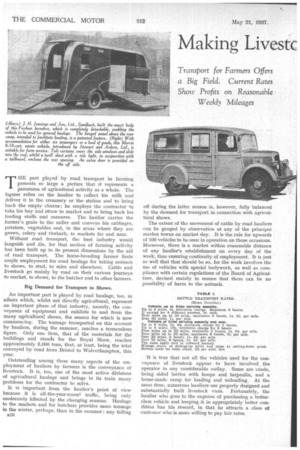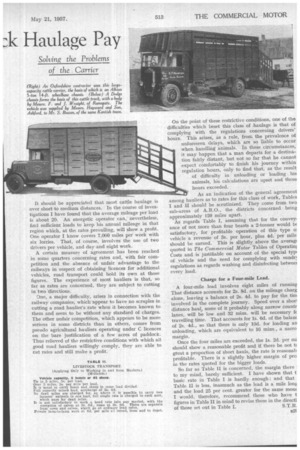Making Livestc :k Haulage Pay
Page 62

Page 63

If you've noticed an error in this article please click here to report it so we can fix it.
Solving the Problems of the. Carrier THE part played by road transport in farming presents so large a picture that it represents a panorama of agricultural activity as a whole. The faimer relies on the haulier to collect his milk and deliver it to the creamery or the station and to bring back the empty churns; he employs the contractor to -take his hay and straw to market and to bring back his feeding stuffs and manures. The haulier carries the farmer's grain to the miller and conveys his cabbages, potatoes, vegetables and, in the areas where they are grown, celery and 'rhubarb, to markets far and near.
Without road transport, the beet industry would languish and die, for that section of farming activity has been built up to its present dimensions by the aid of road transport. The horse-breeding farmer finds ample employment for road haulage for taking animals to shows, to stud, to sales and elsewhere. Cattle and livestock go mainly by road on their various journeys to market, to shows, to the butcher and to other farmers.
Big Demand for Transport to Shows.
An important part is played by road haulage, too, in affairs which, whilst not directly agricultural, represent an important phase of that industry, namely, the conveyance of equipment and exhibits to and from the many agricultural shows, the season for which is now commencing. The tonnage transported on this account by hauliers, during the summer, reaches a tremendous figure. Only one item, that of the materials for the buildings and stands for the Royal Show, reaches approximately 3,000 tons, that, at least, being the total conveyed by road from Bristol to Wolverhampton, this year.
Outstanding among these many aspects of the employment of hauliers by farmers is the conveyance of livestock. It is, too, one of the most active divisions of agricultural haulage and brings in its train many problems for the contractor to solve.
It is important from the haulier's point of view because it is all-the-year-round traffic, being only moderately hffected by the changing seasons. Haulage to the markets and for butchers provides more tonnage hi the winter, perhaps, than in the summer' any falling ii28 off during the latter season is, however, fully balanced by the demand for transport in connection with agricultural shows.
The extent of the movement of cattle by road hauliers can be gauged by observation at any of the principal market towns on market day. It is the rule for upwards of 100 vehicles to be seen in operation on those occasions. Moreover, there is a market within reasonable distance of any haulier's establishment on every day of the week, thus ensuring continuity of employment. It is just as well that that should be so, for the work involves the use of vehicles with special bodywork, as well as compliance with certain regulations of the Board of Agriculture, devised mainly to ensure that there can he no possibility of harm to the animals.
It is true that not all the vehicles used for the conveyance of livestock appear to have involved the operator in any considerable outlay. Some are crude, being sided lorries with hoops and tarpaulin, and a home-made ramp for loading and unloading. At the same time, numerous hauliers use properly designed and substantially built livestock vans. Fortunately, the haulier who goes to the expense of purchasing a betterclass vehicle and keeping it in appropriately better condition has his reward, in that he attracts a class of customer who is more willing to pay fair rates.
It should be appreciated that most cattle haulage is over short to medium distances. In the course of investigations I have found that the average mileage per load is about 20. An energetic operator can, nevertheless, find sufficient loads to keep his annual mileage in that region which, at the rates prevailing, will show a profit. One operator I know covers 7,000 miles per week with six lorries. That, of course, involves the use of two drivers per vehicle, and day and night work.
A certain measure of agreement has been reached in some quarters concerning rates and, with fair competition and the absence of unfair advantage to the railways in respect of cbtaining licences for additional vehicles, road transport could hold its own at those figures. The experience of most hauliers is that, so far as rates are concerned, they are subject to cutting in two directions.
One, a major difficulty, arises in connection with the railway companies, which-appear to have no scruples in cutting a road haulier's rate when it becomes known to them and seem to be without any standard of charges. The other unfair competition, which appears to be more serious in some districts than in others, comes from pseudo agricultural hauliers operating under C licences on the bare justification of a few acres of paddock. Thus relieved of the restrictive conditions with which all good road hauliers willingly comply, they are able to cut rates and still make a profit. On the point of these restrictive conditions, one of the difficulties which beset this class of ,haulage is that of complying with the regulations concerning drivers' hours. This arises-, as a rule, from the prevalence of unforeseen delays, which are so liable to occur when handling animals. In these circumstances, it may happen that a man departs bra destination fairly distant, but not so far that he cannot expect comfortably to finish his journey within regulation hours, only to find that, as the result of difficulty in unloading or loading his animals, his calculations are upset and those hours exceeded.
As an indication of the general agreement among hauliers as to rates for this class of work, Tables I and II should be scrutinized. They come from two sub-areas of A.R.O., the districts concerned being approximately 120 miles apart.
As regards Table I, assuming that for the convey. ance of not more than four beasts a 2-tonner would bc satisfactory, for profitable operation of this type oi vehicle a revenue of 3s. per hour, plus 4d. per mile should be earned. This is slightly above the averag( quoted in The Commercial Motor Tables of Operatini Costs and is justifiable on account of the special typi of vehicle and the need for complying with sundr■ regulations as regards washing and disinfecting betweei every load.
Charge for a Four-mile Lead.
• A four-mile lead involves eight miles of. running That distance accounts for 2s. 8d. on the mileage charg alone, leaving a balance of 2s. 4d. to pay for the tim involved in the complete journey. Speed over a shori distance haul, some of it probably along narrow countr lanes, will be low and 32 mins. will be necessary fc travelling time. That accounts for is. 6d, of the balanc of 2s. 4d., so that there is only 10d. for loading an unloading, which are equivalent to 16 mins:, a narro margin.
Once the four miles are exceeded, the is. 2d. per mi should show a reasonable profit and if there be not tc great a proportion of short hauls, the rate is reasonab profitable. There is a slightly higher margin of pro in the rates quoted for the bigger loads.
So far as Table TI is concerned, the margin there to my mind, barely sufficient. I have shown that t basic rate in Table I is hardly enough : and that Table II is less, inasmuch as the lead is a mile long and the load 25 per cent, greater for the same MOUE I would, therefore, recommend those who have t figures in Table II in mind to revise them in the directi
of those set out in Table I. S.T.R.




































































































